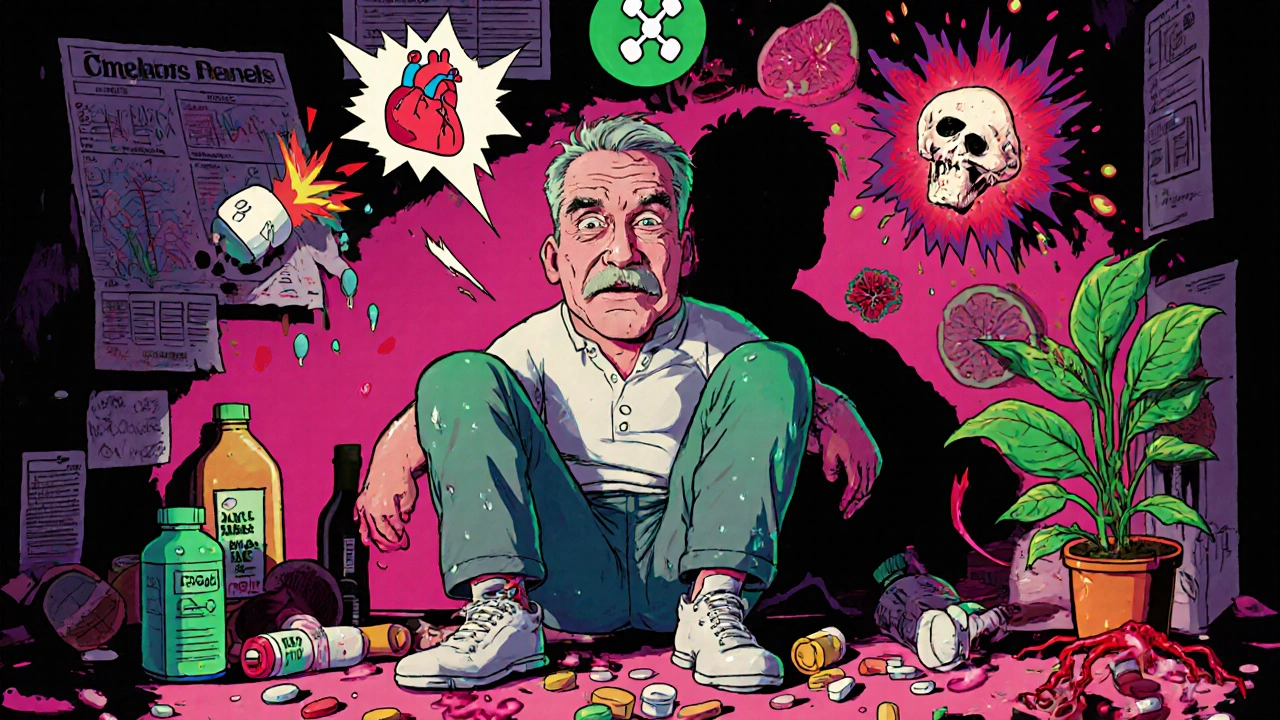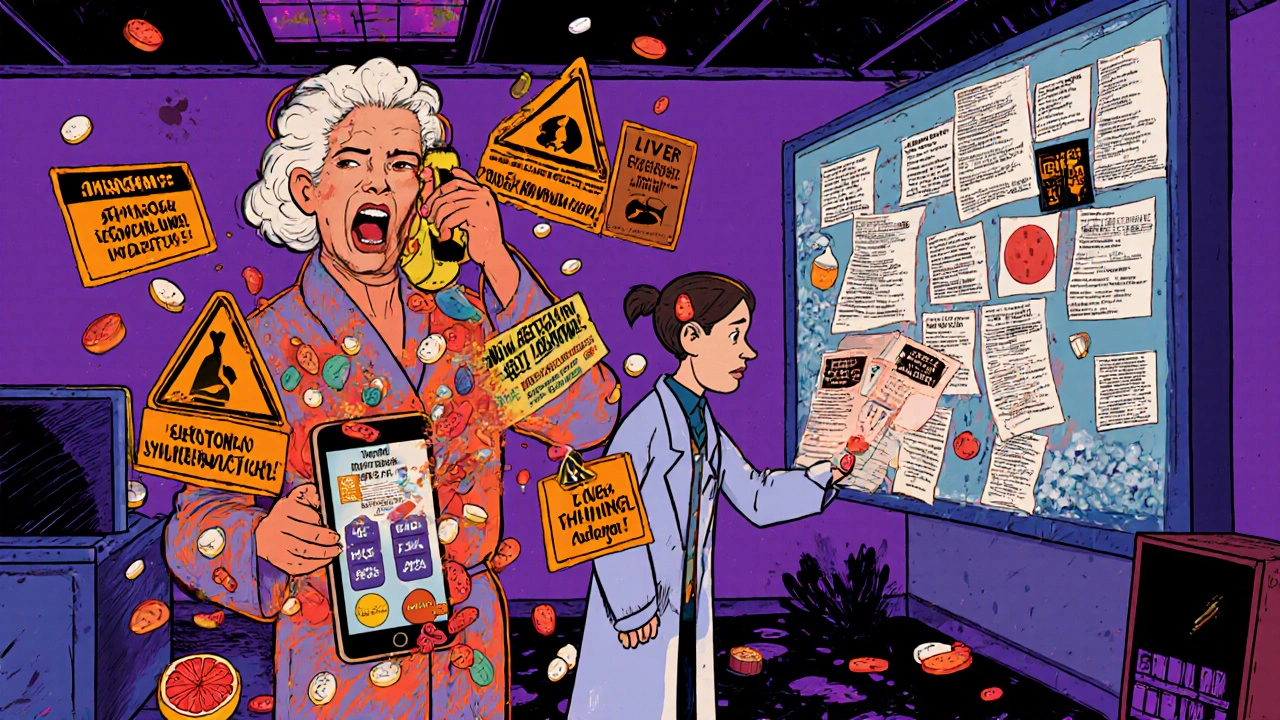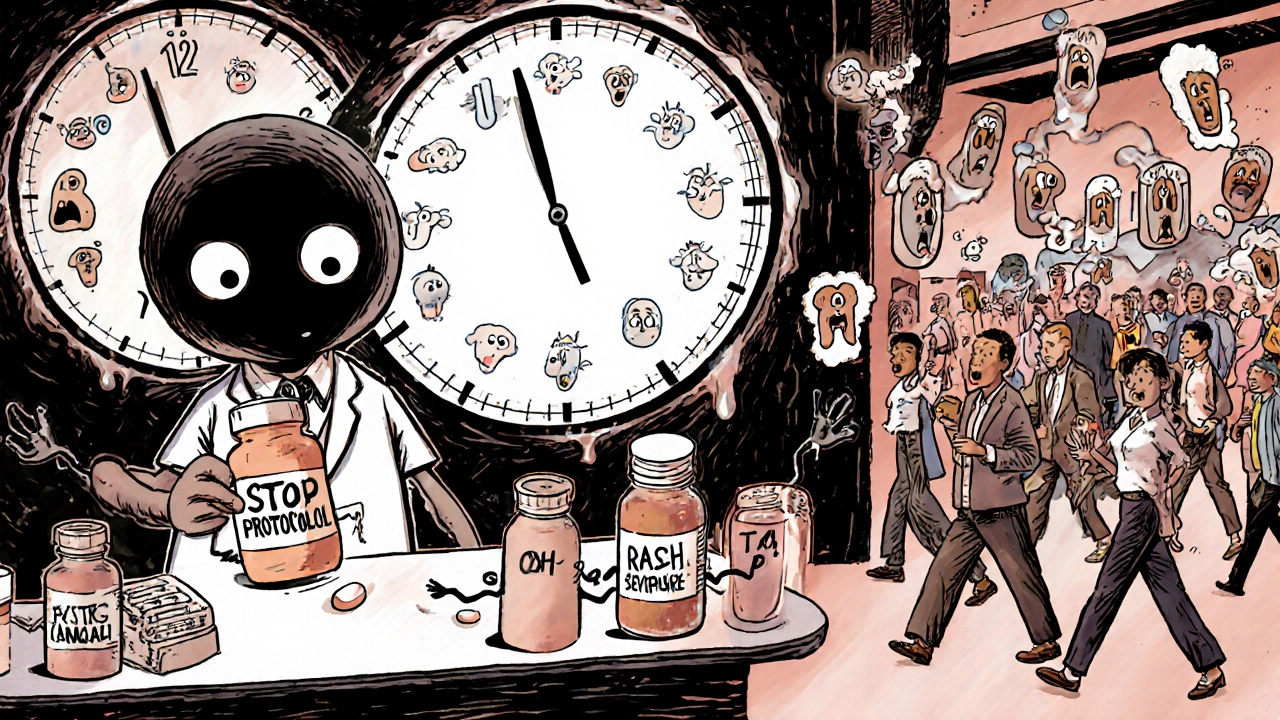 Nov, 17 2025
Nov, 17 2025
It’s easy to think that taking a few extra pills or mixing a supplement with your prescription is harmless. But drug interactions aren’t just theoretical risks-they can turn a routine day into a medical emergency. You might feel a little dizzy after starting a new antibiotic. Or your heart races after taking painkillers with your antidepressant. At first, you might brush it off as stress, fatigue, or a bad night’s sleep. But if you’re on more than one medication-especially if you’re over 65-those symptoms could be a red flag.
What Counts as a Dangerous Drug Interaction?
A drug interaction happens when one substance changes how another works in your body. It can make a drug too strong, too weak, or create entirely new side effects. The most dangerous ones involve drugs with a narrow therapeutic index-like warfarin, digoxin, or phenytoin. A 20% change in blood levels of these can cause seizures, heart failure, or fatal bleeding. These aren’t rare cases. The FDA reports that drug interactions contribute to over 1.3 million emergency room visits in the U.S. every year. And nearly half of those could have been prevented.There are three main types:
- Drug-drug (60% of serious cases): Like mixing blood thinners with NSAIDs or SSRIs with migraine meds.
- Drug-food (20%): Grapefruit juice with statins, dairy with antibiotics, or alcohol with sedatives.
- Drug-disease (20%): Taking decongestants if you have high blood pressure, or NSAIDs if you have kidney disease.
Even herbal supplements count. St. John’s Wort can make birth control, antidepressants, and heart meds useless. Garlic supplements can thin your blood like aspirin. Many people don’t realize these are drugs too.
Symptoms That Require Immediate Emergency Care
If you’re experiencing any of these, call emergency services right away-don’t wait, don’t text your doctor, don’t Google it. Time matters.- Difficulty breathing or oxygen levels below 90%: This can mean anaphylaxis or severe lung reaction. Pulse oximeters are widely available-use one if you have it.
- Swelling of the face, lips, tongue, or throat: This isn’t just a rash. It’s angioedema. Airway can close within minutes.
- Systolic blood pressure below 90 mmHg with a heart rate over 120: Your body is going into shock. This is anaphylaxis or severe serotonin syndrome.
- Seizures lasting more than 2 minutes: Especially if you’re on antidepressants, painkillers, or antibiotics. Lidocaine toxicity from dental procedures has caused this in documented cases.
- Temperature above 41.1°C (106°F), rigid muscles, and uncontrollable agitation: Classic signs of serotonin syndrome. Happens when two serotonergic drugs are combined-like SSRIs with tramadol or fentanyl.
- High fever, dark urine, muscle pain, and confusion: Could be neuroleptic malignant syndrome, especially if you’re on antipsychotics.
These aren’t "maybe" situations. They’re life-or-death. The World Allergy Organization says that if you have two or more of these: rapid heartbeat, fast breathing, sweating, dilated pupils, tremors, or overactive reflexes-you likely have serotonin syndrome. And it’s 97% accurate if those symptoms appear together.
Symptoms That Need Medical Attention Within 24 Hours
These won’t kill you in minutes, but they can lead to organ damage if ignored.- Widespread rash covering more than 30% of your body: Could be DRESS syndrome-a delayed allergic reaction that attacks your liver, kidneys, or blood cells. Often shows up 2-6 weeks after starting a new drug.
- Unexplained fever over 38.5°C (101.3°F) for more than 48 hours: Especially if you’re on antibiotics, anticonvulsants, or sulfa drugs. Could be serum sickness or a drug-induced immune reaction.
- Unusual bruising, bleeding gums, or nosebleeds: Platelets below 100,000/μL means your blood can’t clot. Happens with some antibiotics, diuretics, or chemotherapy drugs.
- Yellow skin or eyes, dark urine, or pain under your right ribs: ALT levels over 120 U/L suggest liver damage. Drug-induced liver injury is silent until it’s advanced.
- Little or no urine for 6+ hours, swelling in legs, or sudden weight gain: Could mean kidney damage. One in five acute kidney injury cases in hospitals come from medications.
These signs don’t always scream "danger." But they’re your body’s way of saying something’s wrong. Waiting a day or two to see if it gets better can turn a treatable problem into a hospital stay.

Why People Wait Too Long-And What Happens When They Do
A 2022 survey of 1,200 patients found that 58% waited over 12 hours before seeking help for symptoms like dizziness or nausea. Why? They thought it was "just a side effect." Or they didn’t realize their new supplement was interacting with their blood pressure pill.On Reddit, users shared stories of being on SSRIs and getting fentanyl at the dentist. Within hours: sweating, shaking, confusion. They thought it was anxiety. One man waited 18 hours before going to the ER-by then, he needed ICU care. Another person took melatonin with an antidepressant and developed serotonin syndrome. She thought she was just "feeling off." She didn’t connect the dots until her hands started twitching uncontrollably.
Meanwhile, those who acted fast had better outcomes. The American Association of Poison Control Centers found that 89% of people who called poison control within an hour of noticing symptoms avoided the ER entirely. That’s not luck. That’s knowing what to do.
What to Do Right Now
You don’t need to be a pharmacist to protect yourself. Here’s a simple plan:- Keep a full list of everything you take: Prescription drugs, over-the-counter meds, vitamins, herbs, even CBD or melatonin. Write down doses and times.
- Use a trusted drug interaction checker: Drugs.com’s free tool screens 24,000+ medications. Or ask your pharmacist to run a check-most pharmacies do it for free.
- Learn the "STOP" protocol: Stop the suspected drug, Tell your doctor or pharmacist, Observe your symptoms, Present all your meds at the appointment.
- Don’t assume your doctor knows: A 2022 study found 68% of patients couldn’t recognize serious interaction symptoms from their medication leaflets. Your doctor might miss it too-especially if they’re overwhelmed by alert fatigue.
Even if you think you’re careful, polypharmacy is common. The average person over 65 takes five or more medications. That gives you a 57% chance of a major interaction. It’s not your fault. It’s the system.

How Healthcare Providers Are Trying to Fix This
Hospitals now use barcode scanning to match meds to patients-reducing errors by 41%. Electronic health records are supposed to flag dangerous interactions. But only 63% of systems properly grade severity. Some doctors get so many alerts they start ignoring them.Tools like Lexicomp and Micromedex are updated daily. The Liverpool Drug Interaction Group’s checker is especially good for HIV and transplant patients. And AI is getting smarter: IBM Watson Drug Insights predicted 89% of new interactions in a 2022 study.
But technology alone won’t save you. You’re the most important link in the chain. If you notice something off-trust it.
Final Thought: Your Body Knows Before You Do
Medications are powerful. They save lives. But they also carry hidden risks. The best defense isn’t memorizing every possible interaction. It’s paying attention to your body and acting fast when something feels wrong.If you’re on more than three meds, talk to your pharmacist every six months. If you feel dizzy, nauseous, or just "not yourself" after starting something new-don’t wait. Call your doctor. Or go to urgent care. Or call poison control. It’s better to be safe than sorry.
Because when it comes to drug interactions, timing isn’t just important-it’s everything.
Can over-the-counter meds cause dangerous drug interactions?
Yes. Common OTC drugs like ibuprofen, antacids, cold medicines, and even antihistamines can interact with prescriptions. For example, ibuprofen can increase bleeding risk if you’re on warfarin. Antacids can block absorption of antibiotics like ciprofloxacin. Even sleep aids like diphenhydramine can worsen confusion in older adults on dementia meds. Always check with a pharmacist before taking anything new, even if it’s "just a pill from the shelf."
How long after starting a new drug do interactions usually appear?
It varies. Some reactions happen within hours-like anaphylaxis or serotonin syndrome. Others take days or weeks. DRESS syndrome can appear 2 to 6 weeks after starting a drug. Liver damage might not show up until after months of use. That’s why it’s important to monitor your body even if you’ve been on a new medication for a while. Don’t assume you’re "used to it."
Is it safe to take herbal supplements with my prescription drugs?
Not without checking. St. John’s Wort can make birth control, antidepressants, and blood thinners ineffective. Garlic and ginkgo can thin your blood and increase bleeding risk during surgery. Ginseng can raise blood pressure and interfere with diabetes meds. A 2021 NIH study found herbal supplements caused 18% of serious drug interactions. Always tell your doctor and pharmacist exactly what supplements you’re taking-even if you think they’re "natural" or "safe."
What should I bring to the doctor if I suspect a drug interaction?
Bring all your medications in their original bottles-including prescriptions, OTC drugs, vitamins, herbs, and even topical creams. This helps the doctor see exact names, doses, and frequencies. A photo of your pill organizer won’t cut it. Labels often have crucial details like strength and manufacturer. Also write down when you started each medication and what symptoms you’ve noticed, including when they started and how they’ve changed.
Can drug interactions happen even if I take my meds at different times of day?
Yes. Many interactions aren’t about timing-they’re about chemistry. For example, grapefruit juice affects how your liver breaks down drugs like statins, regardless of when you eat or take your pill. Some drugs build up in your system over days. Even if you space them out, the interaction still happens. The key isn’t when you take them-it’s whether they’re compatible at all. Always check for interactions before combining any medications.
What if I can’t afford to go to the ER? Should I just wait it out?
If you’re having symptoms like trouble breathing, chest pain, swelling, seizures, or high fever-don’t wait. These aren’t conditions you can manage at home. Delaying care can lead to permanent organ damage or death. Many hospitals have financial assistance programs, and emergency care is legally required regardless of ability to pay. For less urgent symptoms, call poison control (1-800-222-1222 in the U.S.)-they’re free, confidential, and can guide you on whether you need to go in.
